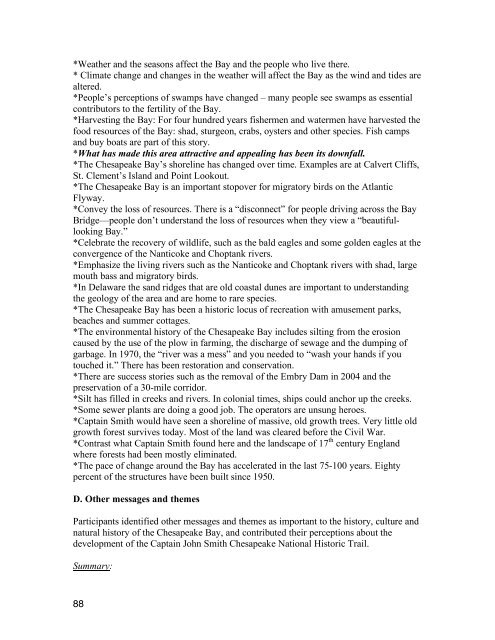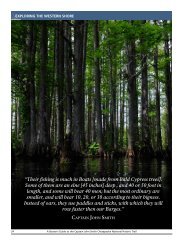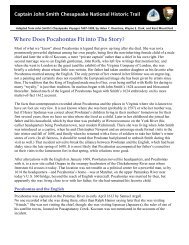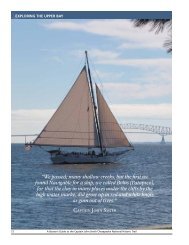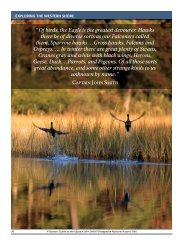Draft Interpretive Plan Join the adventure! - Captain John Smith ...
Draft Interpretive Plan Join the adventure! - Captain John Smith ...
Draft Interpretive Plan Join the adventure! - Captain John Smith ...
Create successful ePaper yourself
Turn your PDF publications into a flip-book with our unique Google optimized e-Paper software.
*Wea<strong>the</strong>r and <strong>the</strong> seasons affect <strong>the</strong> Bay and <strong>the</strong> people who live <strong>the</strong>re.<br />
* Climate change and changes in <strong>the</strong> wea<strong>the</strong>r will affect <strong>the</strong> Bay as <strong>the</strong> wind and tides are<br />
altered.<br />
*People’s perceptions of swamps have changed – many people see swamps as essential<br />
contributors to <strong>the</strong> fertility of <strong>the</strong> Bay.<br />
*Harvesting <strong>the</strong> Bay: For four hundred years fishermen and watermen have harvested <strong>the</strong><br />
food resources of <strong>the</strong> Bay: shad, sturgeon, crabs, oysters and o<strong>the</strong>r species. Fish camps<br />
and buy boats are part of this story.<br />
*What has made this area attractive and appealing has been its downfall.<br />
*The Chesapeake Bay’s shoreline has changed over time. Examples are at Calvert Cliffs,<br />
St. Clement’s Island and Point Lookout.<br />
*The Chesapeake Bay is an important stopover for migratory birds on <strong>the</strong> Atlantic<br />
Flyway.<br />
*Convey <strong>the</strong> loss of resources. There is a “disconnect” for people driving across <strong>the</strong> Bay<br />
Bridge—people don’t understand <strong>the</strong> loss of resources when <strong>the</strong>y view a “beautifullooking<br />
Bay.”<br />
*Celebrate <strong>the</strong> recovery of wildlife, such as <strong>the</strong> bald eagles and some golden eagles at <strong>the</strong><br />
convergence of <strong>the</strong> Nanticoke and Choptank rivers.<br />
*Emphasize <strong>the</strong> living rivers such as <strong>the</strong> Nanticoke and Choptank rivers with shad, large<br />
mouth bass and migratory birds.<br />
*In Delaware <strong>the</strong> sand ridges that are old coastal dunes are important to understanding<br />
<strong>the</strong> geology of <strong>the</strong> area and are home to rare species.<br />
*The Chesapeake Bay has been a historic locus of recreation with amusement parks,<br />
beaches and summer cottages.<br />
*The environmental history of <strong>the</strong> Chesapeake Bay includes silting from <strong>the</strong> erosion<br />
caused by <strong>the</strong> use of <strong>the</strong> plow in farming, <strong>the</strong> discharge of sewage and <strong>the</strong> dumping of<br />
garbage. In 1970, <strong>the</strong> “river was a mess” and you needed to “wash your hands if you<br />
touched it.” There has been restoration and conservation.<br />
*There are success stories such as <strong>the</strong> removal of <strong>the</strong> Embry Dam in 2004 and <strong>the</strong><br />
preservation of a 30-mile corridor.<br />
*Silt has filled in creeks and rivers. In colonial times, ships could anchor up <strong>the</strong> creeks.<br />
*Some sewer plants are doing a good job. The operators are unsung heroes.<br />
*<strong>Captain</strong> <strong>Smith</strong> would have seen a shoreline of massive, old growth trees. Very little old<br />
growth forest survives today. Most of <strong>the</strong> land was cleared before <strong>the</strong> Civil War.<br />
*Contrast what <strong>Captain</strong> <strong>Smith</strong> found here and <strong>the</strong> landscape of 17 th century England<br />
where forests had been mostly eliminated.<br />
*The pace of change around <strong>the</strong> Bay has accelerated in <strong>the</strong> last 75-100 years. Eighty<br />
percent of <strong>the</strong> structures have been built since 1950.<br />
D. O<strong>the</strong>r messages and <strong>the</strong>mes<br />
Participants identified o<strong>the</strong>r messages and <strong>the</strong>mes as important to <strong>the</strong> history, culture and<br />
natural history of <strong>the</strong> Chesapeake Bay, and contributed <strong>the</strong>ir perceptions about <strong>the</strong><br />
development of <strong>the</strong> <strong>Captain</strong> <strong>John</strong> <strong>Smith</strong> Chesapeake National Historic Trail.<br />
Summary:<br />
88


